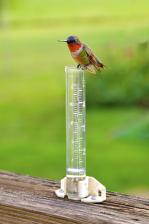Original Article: http://www.quickanddirtytips.com/education/math/how-is-rainfall-measured?page=1
What does it mean when it rains an inch? How is rainfall measured? How can you measure it yourself? And how much rain falls on your roof in a big storm? Those are exactly the questions we'll be talking about today..
How Is Rainfall Measured?
As you probably know, rainfall amounts in the United States are typically measured in inches. Actually, although we usually just say "inches," we really mean "inches in the storm" or "inches in the last 24 hours" or "inches in some time period." Why does that matter? Well, obviously 1 inch of rain in a 15 minute period is a lot more water than 1 inch of rain in the last month. So we really don't know how much it's rained if we don't know the time period we're talking about.
So what does 1 inch, 2 inches, or whatever number of inches of rain in some time period mean? Well, if all the rain that falls stays right where it lands—meaning it doesn't run off and accumulate in streams and rivers and eventually in lakes and oceans, and it isn't absorbed into the ground—then 1 inch of rain in an area is enough to evenly cover the ground in that area with a layer of water 1 inch deep. Of course, water typically does run into streams and is absorbed into the ground, so 1 inch of rain rarely means an inch of standing water.
But whether or not we actually see 1 inch of water on the ground for each inch of rain, we can use this definition to construct a device that measures how much it has rained—a so-called rain gauge.
How Do Rain Gauges Work?
 It's very easy to build a rain gauge. In fact, there's a good chance you did it in school at some point. All you have to do is take a straight-sided can with a flat bottom (like a cylinder), make marks up its side every inch, set it out in the open, and wait for rain. If you see that the can has filled with water up to the 1 inch mark, then you know it has rained 1 inch. Up to the 2 inch mark, it has rained 2 inches.
It's very easy to build a rain gauge. In fact, there's a good chance you did it in school at some point. All you have to do is take a straight-sided can with a flat bottom (like a cylinder), make marks up its side every inch, set it out in the open, and wait for rain. If you see that the can has filled with water up to the 1 inch mark, then you know it has rained 1 inch. Up to the 2 inch mark, it has rained 2 inches.
But, you say, what size should the can be? In other words, does its diameter matter? Nope, any can will do.
Why? Think about it: the height of the water in the can is equal to the volume of water in the can divided by the area of the opening. And the volume of water in the can is proportional to the rate of rainfall (measured in something like drops per square inch) times the area of the can. If we put these together, we find that the area of the can cancels from the top and bottom of the ratio—meaning the area doesn't matter!
How to Make a More Accurate Rain Gauge
As it turns out, straight-sided cans aren't very accurate since small amounts of rain don't change the water level much. One simple way to improve the accuracy of this kind of rain gauge is to use a funnel shaped collector instead of one with straight-sides. The large mouth at the top of the funnel gathers lots of rain and the narrow tube at the bottom means that even a small amount of rain changes the height of the water significantly.
Of course, with this kind of collector 1 inch of water in the gauge does not mean 1 inch of rainfall. Real rain gauges of this type have nice markings on them that let you to accurately tell how much it has rained, but you don't actually need those markings to find out. As we talked about earlier for the straight-sided gauge, the number of inches of rain must be equal to the volume of water divided by the area of the collector. So, by measuring the volume and area, you can determine the number of inches of rain. And you can actually use this technique to determine how the scale should be drawn on your rain gauge in the first place.
How Much Rain Falls On Your Roof?
So how much is 1 inch of rain? By which I mean something like: How many gallons of water land on your roof in a storm that drops 1 inch of rain? The math is actually pretty straightforward—although there are some unit conversions that we need to be careful about along the way.
A 1,000 square foot roof is bombarded by 625 gallons of water per inch of rain.
The main thing to realize is that 1 inch of rainfall is enough to create a 1 inch deep layer of water on your roof. So the total volume of water on your roof is the square footage of your roof—let's say it's 1,000 square feet—times 1 inch = 1/12 of a foot. That's about 83.3 cubic feet of water per inch of rain for a 1,000 square foot roof. How many gallons is that?
There are just about 7.5 gallons in a cubic foot. Which means that a 1,000 square foot roof is bombarded by 83.3 x 7.5 or about 625 gallons of water per inch of rain. How much is that? Well, a typical barrel shaped container used to transport liquids holds 55 gallons. So if you could collect all of that water, you could fill almost 11.5 barrels from a single inch of rain. That's a lot of water!

 877-601-6284
877-601-6284 877-601-6284
877-601-6284



 It's very easy to build a rain gauge. In fact, there's a good chance you did it in school at some point. All you have to do is take a straight-sided can with a flat bottom (like a cylinder), make marks up its side every inch, set it out in the open, and wait for rain. If you see that the can has filled with water up to the 1 inch mark, then you know it has rained 1 inch. Up to the 2 inch mark, it has rained 2 inches.
It's very easy to build a rain gauge. In fact, there's a good chance you did it in school at some point. All you have to do is take a straight-sided can with a flat bottom (like a cylinder), make marks up its side every inch, set it out in the open, and wait for rain. If you see that the can has filled with water up to the 1 inch mark, then you know it has rained 1 inch. Up to the 2 inch mark, it has rained 2 inches.











